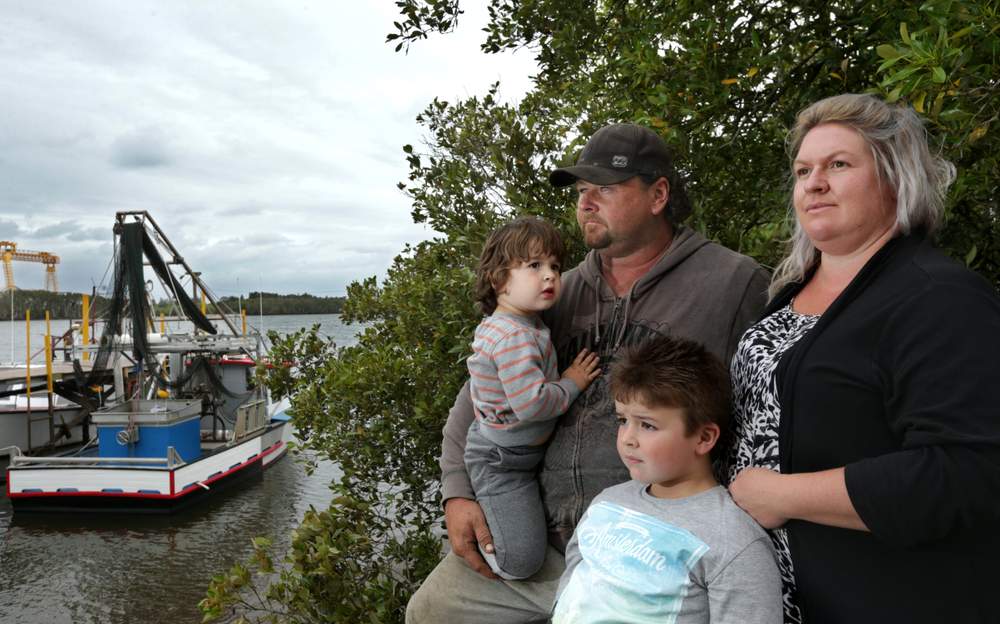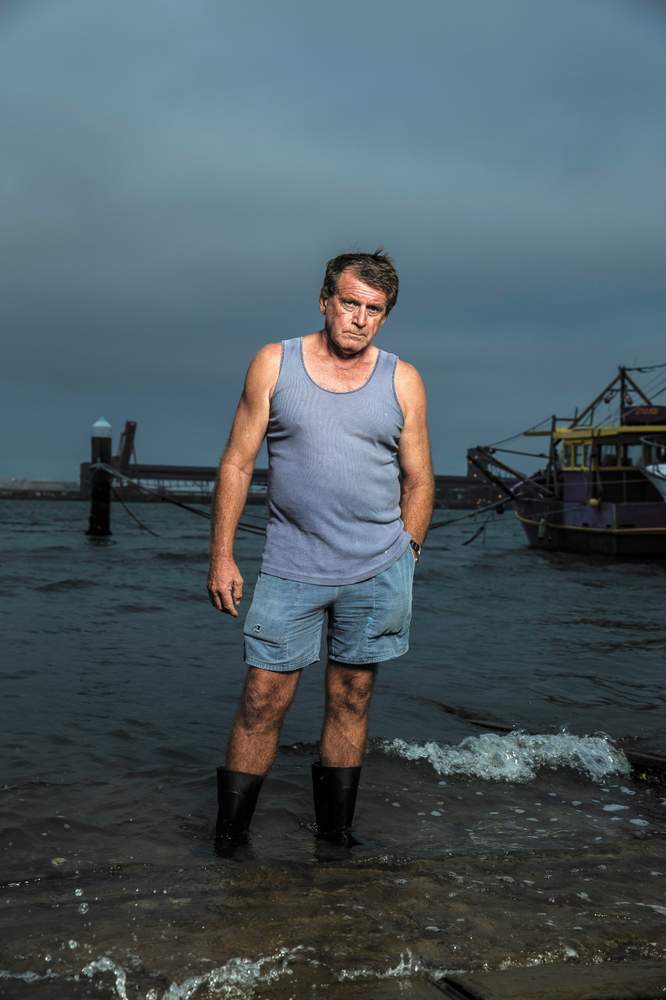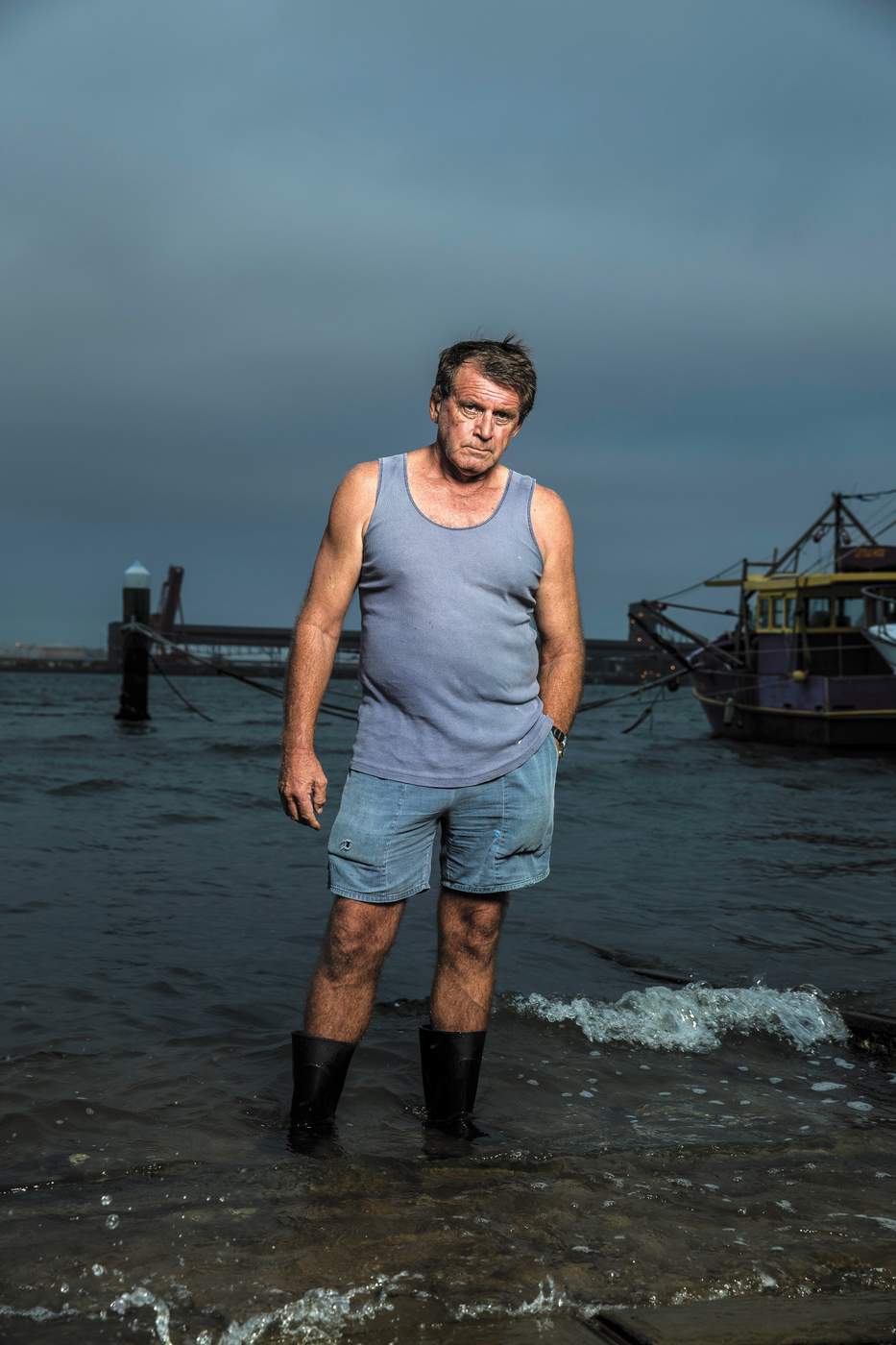The bans on fishing in the Hunter are killing commercial fishers.
Michael McGowan and Carrie Fellner report.
THEY named the Hod for Anne.
They painted it for her too. Yellow and purple, her favourite colours.
A grey nurse shark stalks the bow; the animal she loved.
She died of pneumonia in 2008, 10 years after a car accident on Nelson Bay Road left her a quadriplegic.
Heading south from Williamtown to her parents’ home in Fern Bay late one afternoon, a car coming the opposite direction crossed into her lane and hit her head on.
The driver had fallen asleep behind the wheel.
“She was so close to home where Mum and Dad live,” her younger sister Amanda Hyde said.
Geoff Hyde only mentions his daughter’s death when you ask him about the name of his boat.
“Hod was just one of her nicknames,” he said.
The bubbly veteran of the Hunter’s prawning industry turned 80 on Sunday, celebrating the milestone at what would have been the closure of another prawning season.
Instead, he spent the summer on land for the first time since 1951.
This season, the Hod remained tied to the wharf at Stockton, another victim of the forced closure of Fullerton Cove last September due to PFOS and PFOA contamination from the Williamtown RAAF Base.
Mr Hyde describes it as an “awkward” time. Pat Hyde, his wife, says he’s found things to keep him busy.
Amanda, who spent four seasons working with her father as a deckhand, believes not working the river would have been “devastating” for him.
“Most commercial fishers, they don’t have a retirement age, they just want to do it for the rest of their lives … they really live for that season, it’s what keeps them going,” she said.
“It has been hard on him, really hard.”

Though stationery, the Hod is kept in immaculate condition. He complains loudly when a seagull relieves itself on the deck.
Since 2009, its first season, the boat’s bright colours have made it the most visible trawler working Fullerton Cove.
At 33 feet, she’s one of the biggest too.
“I know he was hoping to get quite a few more seasons out of it too,” Amanda said.
Now that’s out of his hands.
Ideally, Mr Hyde just wants to go back to work doing what he loves on the boat that he made for his daughter.
But if he can’t?
Like most of the prawning vessels in the area, it’s custom built with a shallow draft. That makes it perfect for the Cove’s shallow waters, but not something that can be easily used in other waterways.
If the Cove was closed permanently the boat would be “worthless”, he says.
“I think the government should buy it off me,” he said.
Although the decision to abandon the prawning in the Hunter River this Summer past was technically voluntary, the truth is much more complicated.
Testing done by the Department of Primary Industries last year found prawns caught at five points along the River – Fullerton Cove, near Stockton Bridge, Tomago, Hexham and at Raymond Terrace – all revealed traces of PFOS and PFOA.
Results north of the Hexham Bridge were understood to be so small as to be negligible, but working just that area would have been unsustainable, so the prawners bit the bullet.
“The equation was, make the decision yourself, or we (the department) will make it for you,” is how one commercial fisher described it.

In any case, it meant the estimated $4 million prawning season was lost, leaving the commercial fishers who worked the river living off the meagre Centrelink payments they’ve been offered by the government, and trying to find work where they can.
For some, like Charlie Hutchins from Raymond Terrace, it’s meant travelling to and from Forster every day to work.
“I’m away from home, away from my wife and my family … there’s more to it than meets the eye in terms of what it’s doing … the stress on the family because the income’s not high enough, the accountant telling me I’ve got to push my retirement back five years because I can’t work this season,” he said.
“You got to laugh, because it stops you from crying.”
Chantel Walker says she bawled her eyes out the first time she called the Salvation Army for help.
“It was absolutely devastating,” she said.
“We were hard working Australians, we were brought up that you work hard all your life [and] you earn what you get.
“I felt not ashamed, but a bit embarrassed … I’ve cried about it a long time and then i had to bite the bullet and call and ask."

Since the fishing ban was imposed on the Tilligerry Creek and Fullerton Cove last year, Ms Walker, whose husband John Hewitt is a third generation fisher, has spoken out about the pressure the closures have placed on the families of those impacted.
Eight months later, she says the weight of the scandal is impacting on their young family, including sons Hunter 7, and Parker, 3.
“We trying to keep things normal for the both of them [but] they were used to dad going to work every day [and] they start to ask questions why,” she said.
She said the Department of Defence was not doing enough to fix the situation it created.
“Every child should be brought up to know the Defence force is there to protect us [but] they've taken our right to earn an income away,” she said.
Others, like Kevin Radnidge, explored the option of working areas like the Hawkesbury, but found the cost of buying into the area prohibitive.
“The only two lots of shares I could buy down there, I had to buy a boat and the fishing licence as well,” he said.
“One guy had two lots, he wanted $150,000 all up, another guy was talking about $110,000 to $120,000 all up.”

For that reason, Mr Radnidge describes the $25,000 “business transition payment” offered by the federal government if the fishing ban extends beyond the end of June as “a heap of bullshit”.
“We're snookered,” he said.
“I'm pretty sure it won't be long and some of the guys will start losing houses and things like that.”
And the inherent environmental persistence built into the structure of the toxic legacy firefighting foams means that the chemicals are likely to be spread much further than just Hunter waterways.
Defence has previously confirmed that PFC contamination at Richmond air force base north of Sydney caused fish kills in a creek running into the Hawkesbury River, and a 2011 University of Queensland study found “relatively high” concentrations of the chemicals in North Richmond and Quakers Hill, both at locations that drew water from the Hawkesbury.
While the report states “a plausible explanation for the higher concentrations … is not available at present”, the Herald understands that an earlier version of the study included reference to the proximity of the base, but removed it to avoid appearing speculative.
The concentrations were below provisional guidelines set by the US EPA.
Within the Hunter, the damage from the scandal has forced the fishers who can work to look elsewhere to sell their product.
In March the state government decided to keep the Hunter River open for commercial fishing, despite testing that revealed PFOS and PFOA at levels exceeding the safe criteria.
But the decision to keep it open has not isolated it from damage to the area’s reputation caused by the Williamtown RAAF contamination scandal.
The Herald’s investigation can reveal that fishers still working the river are being forced to go to the Sydney fish market to sell their product, after the Newcastle fishing cooperative placed a ban on fish from the river.
The head of the co-op, Robert Gauta, admitted to cutting off sales from the river, saying the “tough call” had been made to protect the rest of the region’s fishing industry.
“Customers were coming into the shop and saying are those prawns contaminated?,” he said.
“Well, the answer to that question is not no.
“The answer to that question is really, they are contaminated but they're only contaminated to a level that won't affect you.
“That's too difficult to explain to every customer, with every staff member in the shop.”
Mr Gauta conceded the ban had “upset” the region’s industry, and said he wished “it was someone else’s decision”.
“Look we could go the other way and we could take those fish, put them in the window and sell them to a customer knowing full well that they are under the prescribed limit,” he said.
“But we don't want customers to not like that and go away and not come back at all.
“We don't want to damage the co-op [and] the reputation of the rest of our quality seafood.”
Part Four will be published on Thursday.


